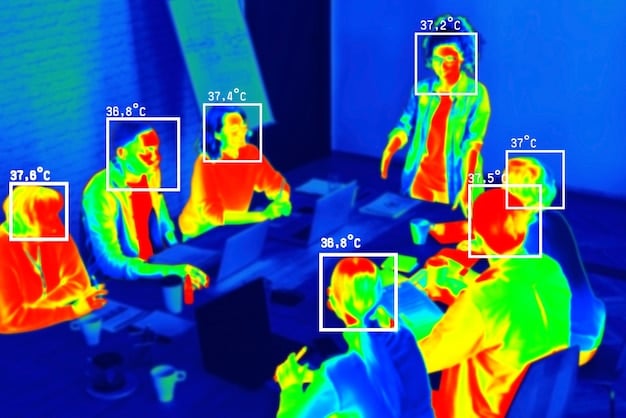Racial Bias in AI: Identifying and Combating Discrimination by 2025

Racial bias in AI refers to algorithms that produce discriminatory outcomes based on race. In 2025, identifying and combating this requires a multi-faceted approach involving diverse datasets, algorithmic transparency, and rigorous testing to ensure fairness and equity.
Artificial Intelligence (AI) is increasingly shaping various facets of our lives, from healthcare and finance to criminal justice. However, if not developed and monitored carefully, AI systems can perpetuate and even amplify existing societal biases, particularly racial biases. Understanding how to identify and combat racial bias in AI: How to Identify and Combat Discrimination in 2025 is crucial to ensuring fairness and equity in a world increasingly driven by algorithms.
Understanding Racial Bias in AI
Racial bias in AI arises when algorithms produce discriminatory outcomes based on race. This can occur due to biased training data, flawed algorithm design, or unintended interactions between AI systems and the social contexts in which they are deployed. Understanding the root causes of this bias is the first step toward addressing it.
AI systems learn from data, and if that data reflects existing societal biases, the AI will likely replicate and reinforce those biases. For example, if a facial recognition system is trained primarily on images of white faces, it may perform poorly when identifying individuals of other races, leading to misidentification or false accusations.
Sources of Racial Bias in AI
Several factors contribute to the presence of racial bias in AI systems. These sources must be identified and addressed to ensure fairness and equity.
- Biased Training Data: AI algorithms learn from data, so if the data is skewed or unrepresentative, the AI will likely produce biased results.
- Algorithmic Design: The design of the algorithm itself can introduce bias, whether intentional or unintentional. Choices made about which features to prioritize or how to weight different variables can have discriminatory outcomes.
- Lack of Diversity in Development Teams: AI systems are often developed by teams that lack diversity, leading to blind spots and a failure to consider the needs and perspectives of different racial groups.
Addressing these sources of bias requires a concerted effort to ensure that AI systems are developed and deployed in a way that promotes fairness and equity, leading to more just outcomes for all members of society.
Identifying Racial Bias in AI Systems
Identifying racial bias in AI systems is crucial before they are widely deployed. This involves evaluating the AI’s performance across different racial groups to ensure that it is fair and equitable. There are several methods and metrics that can be used to detect bias.
One effective approach is to use diverse datasets to test the AI system. By comparing the AI’s performance across different racial groups, it becomes clear whether there are disparities. Disparities may indicate bias in the AI model.

Methods for Detecting Bias
There are several quantitative and qualitative methods that can be used for detecting racial bias in AI systems. These should give insight into potential issues.
- Performance Metrics: Evaluate the AI’s performance across different racial groups using metrics such as accuracy, precision, and recall. Significant disparities in these metrics may indicate bias.
- Adversarial Testing: Expose the AI system to carefully crafted inputs designed to exploit vulnerabilities and uncover biases.
- Algorithmic Audits: Conduct independent audits of AI algorithms to identify potential sources of bias and ensure compliance with ethical guidelines.
By systematically applying these methods, organizations can identify and address potential biases in AI systems, promoting fairness and equity.
Algorithmic Transparency and Explainability
Algorithmic transparency and explainability are essential tools for combating racial bias in AI. Transparency refers to the ability to understand how an AI algorithm works, while explainability involves the ability to understand why an AI made a specific decision.
When algorithms are transparent and explainable, it is easier to identify and address potential sources of bias. Explainable AI (XAI) techniques are particularly valuable in this regard.
The Role of Explainable AI (XAI)
Explainable AI (XAI) techniques provide insights into the decision-making processes of AI systems, helping to uncover and mitigate biases. XAI methods include:
- Feature Importance Analysis: Identify which features or variables the AI is relying on to make decisions. If the AI is relying on race or proxies for race, this may indicate bias.
- Decision Tree Visualization: Visualize the decision-making process of the AI using decision trees. This can help to identify potential sources of bias in the algorithm’s logic.
- Counterfactual Explanations: Generate examples of how changing certain inputs would change the AI’s decision. This can help to understand the AI’s sensitivity to different factors, including race.
XAI can play a pivotal role in improving public trust in AI systems, as it creates pathways to understand why decisions happen.
Strategies for Mitigating Racial Bias in AI
Mitigating racial bias in AI requires a multi-faceted approach that addresses the sources of bias at every stage of the AI development lifecycle, from data collection to algorithm design to deployment.
One important strategy is to use diverse and representative training data. This involves actively seeking out data that reflects the diversity of the population and addressing any imbalances in the data.

Best Practices for Data Collection and Preprocessing
Data collection and preprocessing are critical steps in mitigating racial bias in AI. Best practices include:
- Data Augmentation: Use data augmentation techniques to increase the representation of underrepresented groups in the training data.
- Bias Detection in Data: Use statistical methods to identify potential biases in the training data and correct them before training the AI model.
- Data Governance Policies: Establish clear data governance policies that ensure data is collected and used in an ethical and responsible manner.
Adopting these practices can significantly reduce the risk of perpetuating biases in AI systems. Using synthetic data to augment real-world data can also help create a more balanced, less discriminatory model.
Ethical Frameworks and Regulations
Ethical frameworks and regulations play a crucial role in guiding the responsible development and deployment of AI. These frameworks provide a set of principles and guidelines for ensuring that AI systems are fair, transparent, and accountable.
Many organizations and governments are developing ethical frameworks for AI, including the European Union’s AI Act and the IEEE’s Ethically Aligned Design.
The Role of AI Ethics Boards
AI ethics boards can provide guidance on ethical issues related to AI, review AI projects for potential biases, and develop best practices for responsible AI development. These boards typically include:
- Interdisciplinary Expertise: Members with expertise in fields such as computer science, law, ethics, and social science.
- Diversity: Representation from different racial and ethnic groups to ensure that diverse perspectives are considered.
- Independence: Independence from the AI development team to ensure objectivity and impartiality.
AI ethics boards help to foster a culture of ethical awareness and responsible AI development.
The Future of Combating Racial Bias in AI
The future of combating racial bias in AI requires ongoing research, collaboration, and a commitment to fairness and equity. As AI technology continues to evolve, it’s essential to adapt and refine strategies for identifying and mitigating bias.
One promising area of research is the development of new AI techniques that are inherently more fair and transparent.
Emerging Technologies and Techniques
Several emerging technologies and techniques show promise for combating racial bias in AI:
- Fairness-Aware AI: Develop algorithms that are explicitly designed to be fair, taking into account factors such as race and gender.
- Adversarial Debiasing: Use adversarial training techniques to remove biases from AI models.
- Federated Learning: Train AI models on decentralized data sources while preserving privacy and reducing the risk of bias.
Continued investment in research and development of these technologies is crucial for creating AI systems that benefit all members of society.
| Key Aspect | Brief Description |
|---|---|
| 📊 Data Diversity | Use diverse datasets to train AI and avoid skewed results. |
| 🔎 Bias Detection | Implement methods like algorithm audits to detect and correct biases. |
| 🛡️ Ethical Frameworks | Adhere to ethical guidelines and regulations to ensure AI fairness. |
| 🤖 XAI Implementation | Use Explainable AI techniques to enhance transparency of AI decisions. |
Frequently Asked Questions (FAQ)
▼
Racial bias in AI refers to situations where AI systems produce outcomes that unfairly discriminate against individuals or groups based on their race. This can happen due to multiple factors, notably biased training data.
▼
Identify it through careful evaluation using diverse datasets, reviewing algorithm performance across different races, and conducting algorithmic audits. Look for disparities in accuracy and fairness when evaluating AI outputs.
▼
Use diverse and representative data. Ensure ethical frameworks are followed during development. Make use of fairness-aware AI techniques, and promote algorithmic transparency so that systems may be analyzed effectively.
▼
They guide ethical and responsible AI creation. They establish principles for fairness and accountability by offering standardized ways to assess impact and ensure compliance with ethical and legal mandates.
▼
XAI techniques facilitate the comprehension of AI decisions, revealing any potentially biased areas. Feature importance analysis and decision tree visualization can ensure that algorithms are fair and unbiased.
Conclusion
Combating racial bias in AI requires a sustained, multi-faceted effort. By focusing on data diversity, algorithmic transparency, ethical frameworks, and fairness-aware technologies, we can strive to create AI systems that uphold the principles of justice and equity for all. Continual vigilance and adaptation are key to ensuring a fair and inclusive future for AI.





